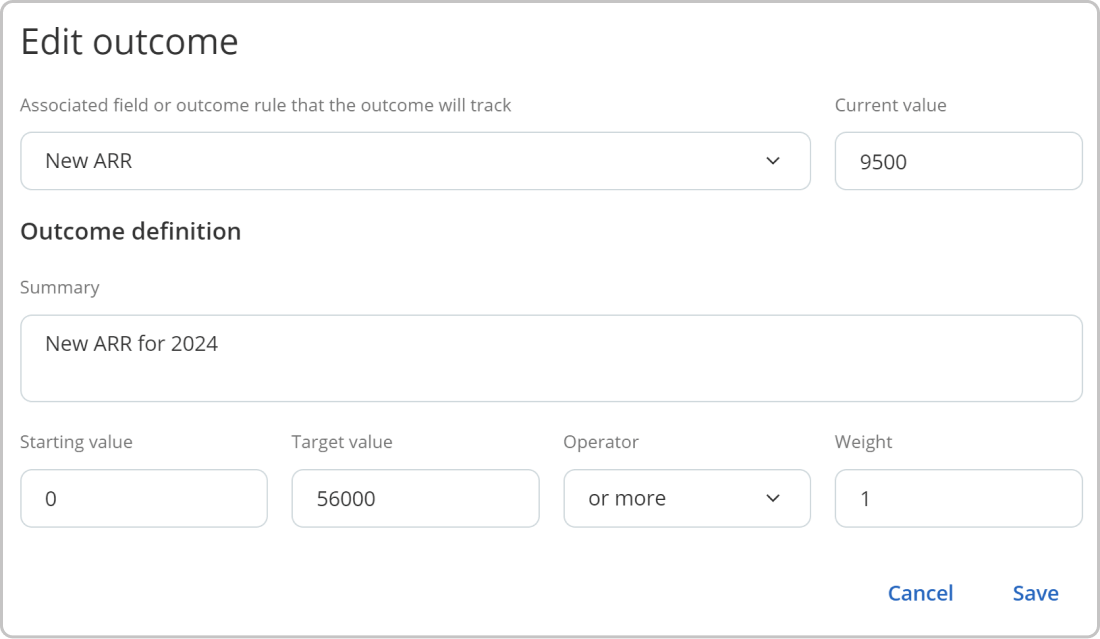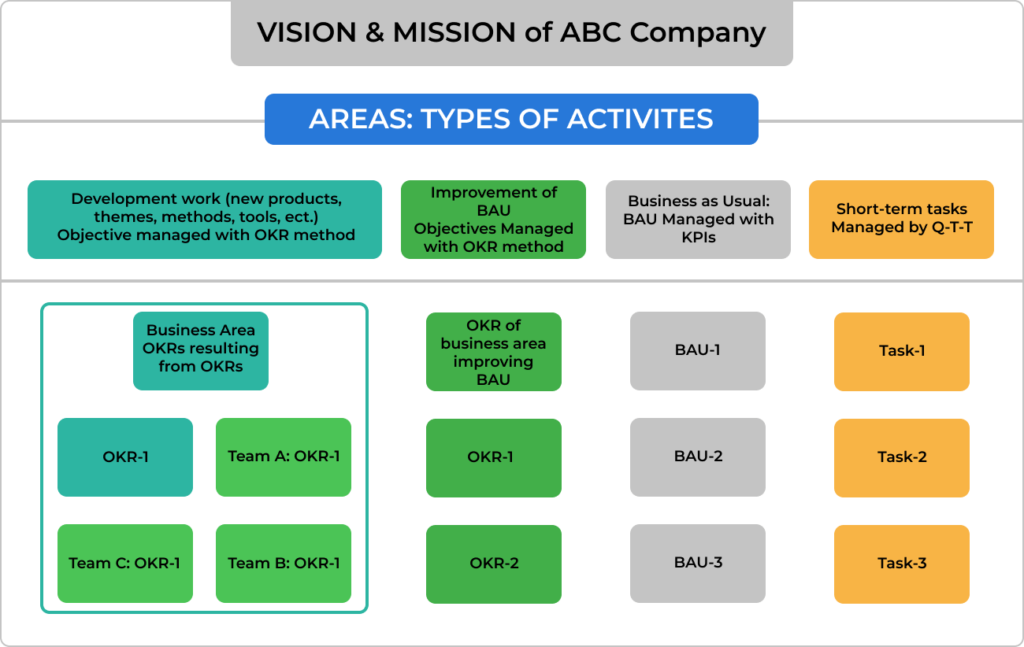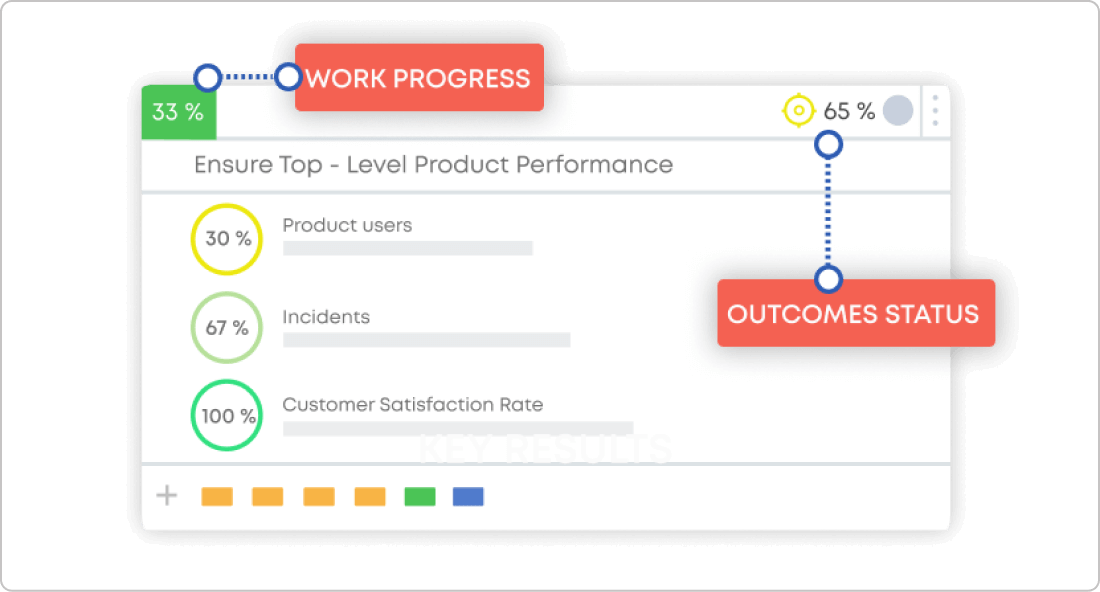The OKR (Objective Key Results) method has gained popularity as an objectives management approach for both development and product goals. However, the "by the book" approach is often dogmatically applied, relying only on a few simple rules and hints from the OKR books. This "copy-and-paste mentality" does not deliver the expected results and often leads to disappointment. Despite high hopes for significant improvement in objectives management, the end result is often underwhelming.
In this article, I'd like to discuss why the standard OKR approach can be like "Swiss cheese". In other words, full of gaps and shortages. I will also share how those pitfalls can be eliminated so applying OKRs can deliver the expected business results.
Using Resulting KRs Only or Adding Signposts for the Journey?
One of the most important classic OKR method simplifications relates to Key Results and its focus mainly on the resulting KRs, while not considering the other KR types, like directional and supporting KRs. All KR types are described in the article Key Results types and their practical application.
What about Key Results Weights?
Key Results in the OKR method relate to the specific Objective. In practice, those KRs quite often have different weights, i.e., the importance of the achievement of the Objective.
Therefore, I would suggest introducing the weights of each of KRs, for example, in the way it is implemented in the Businessmap platform.

Assigning weights to Outcomes
Such KR weight can be used in the formula calculating the status of the Objective's achievement. If we calculate the progress of KR with the formula, such as presented below, then the average value of all KRs, also including their weights, will give us the % progress of an Objective's achievement.
(Actual value - start value)
---------------------------------- x 100 = % KR progress
(Target value - start value)
The Mythical 70% Achievement, or maybe Success Equals the Classic 100%?
The classic OKR method treats the KRs achievement on the 70% level as a success. Such an approach comes from the assumption that the planned level of KR should be ambitious and consequently difficult to achieve.
I think, however, that though such an approach (success at 70% level) is based on a lofty idea of promoting ambitious results, based on my experience, it does not work in practice. 70% blurs the notion of success, sometimes even can be demobilizing. When people are setting goals, they want to achieve them and be proud of their achievements. But how can we be proud of 70% success?
Therefore, I still suggest setting ambitious goals, i.e., defining KR value on the ambitious level but resigning from treating 70% of accomplishments as a success.
Linking OKR Goals with the Strategy or Diagnosis of the Current Situation
Every objective management method should be based on the company strategy. Richard P. Rumelt, in his book "žGood Strategy Bad Strategy", writes that the first element of the core of strategy should be diagnosis. "žDiagnosis that defines or explains the nature of the challenge. Good diagnosis simplifies the often-overwhelmed complexity of reality by identifying certain aspects of the situation as critical".
Also, the common logic indicates that - if I am to define business objectives or the objectives for a new, improved situation in my company, then I must know and understand the current situation.
For instance, if I would like to decrease the level of waste on the production line, then I must understand the reason for such waste. I also need to know how important the issue with production waste is compared to the other company's problems and challenges. This means that as a first step, I should prepare the diagnosis of the problem and later, based on that diagnosis, define the objectives.
Therefore, when helping customers introduce the OKR method, I am always initially asking questions such as: What is the current situation? What is the problem? Do you understand the current situation and problem against the background of other challenges?
This is how we get to the next OKR pitfall - the way the Objective is described in the classic OKR method.
Objectives in the Form of a Slogan or in the Form of a Concise Narrative?
The classic OKR method suggests describing Objectives in a qualitative, inspirational, exciting, and short way - in the form of a slogan. Objectives should be described in the language of people and understandable for co-workers. Such a description helps to remember the Objective and attracts attention. But in practice, very often, it turns out that it is not enough.
A short sentence in the form of a slogan is not enough. Objectives can and should be expressed in the form of a concise narrative. The narrative which is describing why that Objective is so important, what is its connection to the strategy and also presents the broader business context.
Such a 2-3 sentence narrative describing the Objective brings everyone on the same page. Knowledge and understanding of Objectives among the people in the company are key success factors of the OKR.
Differentiation between BAU (Business as Usual) and OKRs Actions
The traditional OKR method overlooks the fact that actions to achieve key results for development goals - which lead to changes and improvements - are often carried out by the same people simultaneously with business-as-usual activities.
For the IT department, BAU can be related to processing requests from businesses or maintenance of IT infrastructure. For the Marketing department, BAU can include marketing projects, as well as everyday marketing operations and contacts with customers and prospects.
And now, on top of such BAU activities, we are adding additional goals (Objectives plus Key Results) and, of course, Actions to achieve those KRs. In such a situation, the question comes: what is more important: BAU or the Actions connected with our development goals? The answer is obvious: it is BAU.
To successfully introduce OKRs for managing development goals, we must consider all company activities and determine where in the business we want to implement and use the OKR method.
The figure below presents a comprehensive overview of how objective management methods are applied to the different business areas in a company.

Visualizing objectives management applied to different business areas
The picture shows the following four activity areas and connects them with objective management methods (from left to right):
1. Area of development activities, changing and improving the situation in the company managed with the help of OKRs.
2. Improvement of BAU where objectives for the specific business area are managed with the help of OKRs.
3. Business as Usual (BAU) is managed with the help of KPIs.
4. Short-term tasks are managed via the following parameters: quality, time and the team carrying out the tasks.
The classic OKR method does not take into account the differentiation between BAU and OKR activities, as well as local improvement areas and short-term tasks. In my opinion, this is one of the most important pitfalls in the classic OKR method resulting in the lack of achievement of OKRs' expected results.
The next gap of the OKR method is closely connected to the one we just discussed. Let's see how a lack of planning for actual execution affects achieving Key Results.
Are You Considering Other Business Activities when Planning Time for OKR Actions?
Very often, companies using committed or aspirational OKRs traditionally assume that team members realize OKR Actions will always have time for them, sometimes even that they can devote 100% of their time. Such managers tend to forget about the other types of activities, like BAU or short-term tasks, as presented in the picture above. They forget that those other activity types also take time.
Failing to allocate sufficient time to OKR Actions while accounting for time spent on other activities, such as BAU and short-term goals, can lead to a shortage of time needed to complete at least one of these activities, oftentimes the OKR Actions. Therefore, Key Results remain unachieved.
The obvious conclusion here is that you need to plan, at least roughly, considering the time your team would spend realizing OKRs actions and taking into account the time needed for additional activities.
Do You Compare the KRs Progress with OKRs Actions Progress?
Effective and efficient objectives management requires you also to consider the Actions leading to the achievement of supporting or directional KRs, sometimes also resulting KRs.
It is, after all, just our hypothesis that specific action will lead to KRs. If such a hypothesis can't be quickly confirmed, then other Actions should be developed and executed, or current actions - refined.
It may happen that I have completed many OKRs Actions, constituting a bigger epic, initiative, or even completed all of them, and "¦ yet I haven't achieved any KR progress. In such a situation, the progress of Actions or the epic would be 100%, but the progress of the KR would be 0.
The opposite situation may also occur. I have completed only a few or even one OKR Action and obtained a significant increase in KR value.
In the first situation, I am accomplishing the Actions completely inefficaciously as Actions don't lead to the increase of KR value. By contrast, in the second situation, I have accomplished such an effective Action that the KR value has increased significantly. The conclusion about which Actions to continue and which to stop is obvious.
But without the comparative analysis conducted during the periodical review (so-called OKR cycle check-ins) of KR status, I will not be able to reach that conclusion.
These analyses can be easily conducted using the right tools. The Businessmap software, for example, automatically calculates the percentage progress of Action. It also automatically calculates the progress (%) of the Objective using the percentile progress of each of the KRs entered manually by users.

Comparison Between OKRs & Work Progress
So, Is the OKR Framework like Swiss Cheese?
It depends. If you go with the traditional route of setting objectives & key results, you may end up with just "another framework" on top of everything else you have in your company. However, OKRs can be really an efficient and effective goal management approach when the following conditions are fulfilled:
- The various KR types are used.
- Simplifications of the classic OKR method of OKR are eliminated.
- Gaps in the Swiss OKR cheese will be glue shut.
- Instead of general, non-context "OKR good practices", the objective management approach aligns with the company context and strategy.
- The elements described in this article are employed when valid for the company context.
Author's bio: Jerzy Stawicki is an expert with over 25 years of experience in project and project portfolio management, helping companies, managers, and teams to work smarter, in a more effective way, and to get more satisfaction. His speciality is Flow Management, based on Lean, Kanban, TOC, and applying the psychology of Flow. And also pragmatic implementation of extended OKRs (Objective Key Results). He is a big fan of Flow simulations: TeamFlow, ProjectFlow, and PortfolioFlow.

Jerzy Stawicki
Guest author
Jerzy Stawicki is an expert with over 25 years of experience in project and project portfolio management, helping companies, managers, and teams to work smarter, in a more effective way, and to get more satisfaction. His specialty is Flow Management, based on Lean, Kanban, TOC, and applying the psychology of Flow. And also pragmatic implementation of extended OKRs (Objective Key Results).



